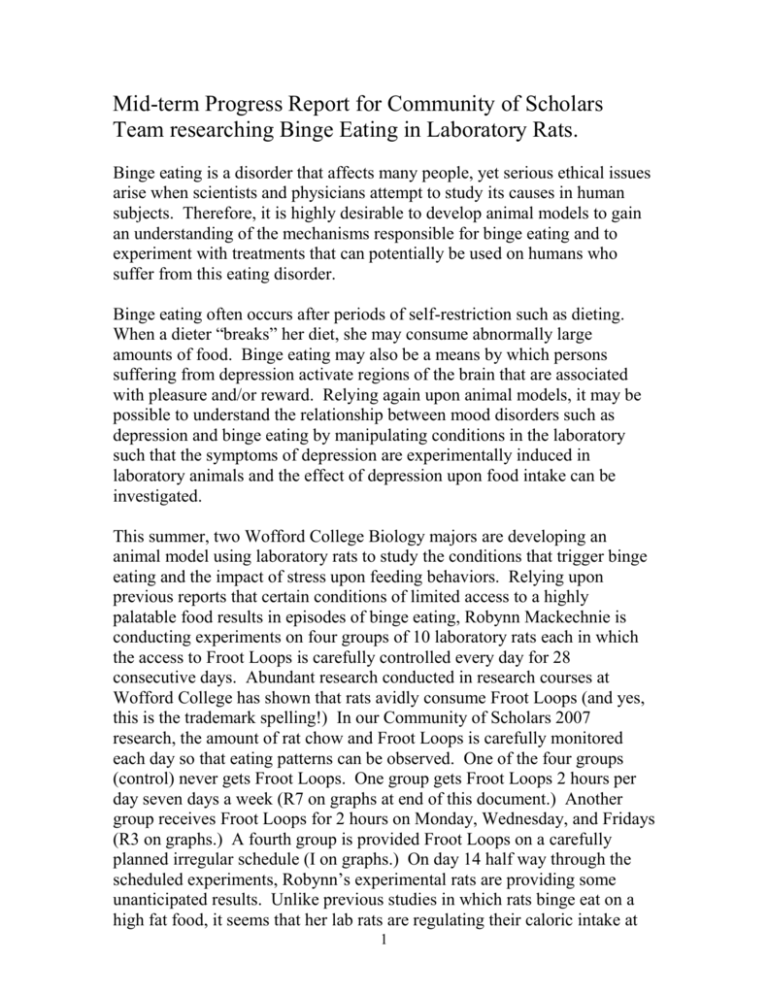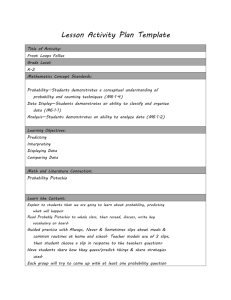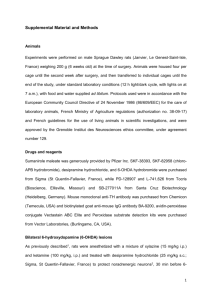Mid-term Progress Report for Community of Scholars Team
advertisement

Mid-term Progress Report for Community of Scholars Team researching Binge Eating in Laboratory Rats. Binge eating is a disorder that affects many people, yet serious ethical issues arise when scientists and physicians attempt to study its causes in human subjects. Therefore, it is highly desirable to develop animal models to gain an understanding of the mechanisms responsible for binge eating and to experiment with treatments that can potentially be used on humans who suffer from this eating disorder. Binge eating often occurs after periods of self-restriction such as dieting. When a dieter “breaks” her diet, she may consume abnormally large amounts of food. Binge eating may also be a means by which persons suffering from depression activate regions of the brain that are associated with pleasure and/or reward. Relying again upon animal models, it may be possible to understand the relationship between mood disorders such as depression and binge eating by manipulating conditions in the laboratory such that the symptoms of depression are experimentally induced in laboratory animals and the effect of depression upon food intake can be investigated. This summer, two Wofford College Biology majors are developing an animal model using laboratory rats to study the conditions that trigger binge eating and the impact of stress upon feeding behaviors. Relying upon previous reports that certain conditions of limited access to a highly palatable food results in episodes of binge eating, Robynn Mackechnie is conducting experiments on four groups of 10 laboratory rats each in which the access to Froot Loops is carefully controlled every day for 28 consecutive days. Abundant research conducted in research courses at Wofford College has shown that rats avidly consume Froot Loops (and yes, this is the trademark spelling!) In our Community of Scholars 2007 research, the amount of rat chow and Froot Loops is carefully monitored each day so that eating patterns can be observed. One of the four groups (control) never gets Froot Loops. One group gets Froot Loops 2 hours per day seven days a week (R7 on graphs at end of this document.) Another group receives Froot Loops for 2 hours on Monday, Wednesday, and Fridays (R3 on graphs.) A fourth group is provided Froot Loops on a carefully planned irregular schedule (I on graphs.) On day 14 half way through the scheduled experiments, Robynn’s experimental rats are providing some unanticipated results. Unlike previous studies in which rats binge eat on a high fat food, it seems that her lab rats are regulating their caloric intake at 1 about 100 kcal per day. On days when Froot Loops are available, they eat a combination of chow and Froot Loops that totals 100 kcal. On days when deprived of Froot Loops, Robynn’s rats consume the same reduced amount of rat chow such that overall energy intake is decreased. These results were not predicted based on how rats behave when given a high fat food intermittently. Rats binge eat (consume a much larger caloric intake) on days when fats are available. Thus, Robynn’s data suggests that rats respond in different ways to highly palatable foods depending on the chemical composition of those foods (fat vs. carbohydrate.) It will be interesting to see if this behavior persists throughout the four weeks of Robynn’s experiments. When her experiments are completed on July 20th, she will need the remaining portion of the Community of Scholar’s 10 weeks duration to delve into the scientific literature on this topic to see how her findings relate to what is known concerning binge eating in laboratory rats. Kishan Govind’s experiments are conducted in parallel with Robynn’s. In addition to the same schedule of access to a highly palatable food, Kishan’s 40 laboratory rats are subjected to a variety of mild stressors that previous researchers have used to induce the symptoms of depression in laboratory rats. These stressors include 36 hours of continuous light once a week which disrupts the diurnal cycling much like severe jet lag. Twice each week, each animal’s cage is tilted at nearly 45 degrees for 3 hours. Also twice each week, eat rat is deprived of water for 18 hours. At the end of 18 hours, an empty water bottle is given to each rat. One hour later, water is finally provided. Another stressor involves keeping the rats in cages for 24 hours in wet bedding. This stressor is akin to the discomfort of lying in a wet sleeping bag for a protracted period. Kishan had to devise a schedule of stressors that would be sufficient to induce what is termed “chronic mild stress” in the literature and characteristics similar to clinical depression in humans. The standard protocol for chronic mild stress used by other laboratories always incorporates food deprivation which, for our purposes, is inappropriate since Kishan is measuring food intake as it is affected by depression. Also, the most effective stressor employed in previous experiments is paired caging of these male rats. Again, since we must accurately measure food intake for each rat, we were unable to include paired caging as a stressor in our experimental protocol. Since all of the previous studies we are aware of have included food deprivation and paired caging as stressors, we were concerned that our protocol might not induce depression. According to the literature, depressed rats don’t eat any less 2 than control rats, but after about 2 weeks of repeated exposure to the stressors, rats subjected to the protocol gain weight at a slower rat that control rats. We were delighted to observe that 10 days into the experiment, Kishan’s stressed rats weighed slightly but statistically significantly less that Robynn’s non-stressed rats which serve as the control animals for his experiments. By day 14, the differences were more pronounced. Furthermore, careful measurements of food intake each day for Kishan’s stressed rats reveals that some stressors have a more profound effect than others. Very interestingly, those rats that are provided Froot Loops only on Mondays, Wednesdays, and Fridays show signs of binge eating although at the midpoint of our experiments, the differences from control animals has yet to reach statistical significance. According to the literature, full manifestation of the symptoms of chronic mild stress often require 2-3 weeks so we eagerly look forward to the completion of our 4 week study. At the moment, it seems likely that stressed rats like stressed humans may eat more palatable foods as a way to “self-medicate” to reduce stress. To reach this point in our research many technical challenges had to be dealt with before the actual experiments could begin. During the week in which our rats acclimated to their new environment and adjusted to their new light/dark schedule (lights on at 4 am, lights off at 4 pm), we conducted several experiments on rats that had been used for other studies in the spring of 2007. For instance, we had to devise a way to provide Froot Loops to rats that would make it convenient to measure how much was consumed (without losing Froot Loops in the bedding of each cage) and in a manner that is similar to the way in which rats eat standard laboratory chow. It was necessary to run a series of pilot studies in which we tested various modes of making Froot Loops available (strung on a hoop of stiff wire, threaded onto a flexible chain, or slipped individually on a stiff rod that could be positioned atop each cage.) The outcome of this set of trials revealed that the optimal mode by which to provide Froot Loops is placing them on a 9 inch long plexiglass rod of 3/16 inch diameter. We discovered that rats don’t eat as much from any of the other modes, including rods of 1/8 inch diameter. Unfortunately, this knowledge forces us to spend considerable time each day making “Froot Loop shish-ke-bobs” for use in our daily experiments. These pilot studies required the same thoughtful planning as our main experiments, the same careful measurement of food intake, and the same types of statistical analysis that we use in our main experiment. The 3 data, statistical analysis, and abstracts of those pilot studies are posted on our website at http://webs.wofford.edu/davisgr/researchsummer2007/ Our mornings spent making shish-ke-bobs, discussing relevant papers from the existing scientific literature, entering data from the previous day’s experiment, and reviewing experimental results. Five days a week including Saturday mornings it is necessary to provide stressors to Kishan’s rats. Twice a week we have to weigh all 80 rats, and for two days each week we are making or cleaning up wet bedding. Since our experiments call for measuring food intake every day for 28 days and since the experiments are conducted simultaneously on 40 rats each kept in two adjoining rooms in the Animal Care Facility, two researchers must be at work every afternoon from 1 pm until 4:30. During that time, in each room we must weigh 130-190 samples of food depending on how many groups of rats are given access to Froot Loops that day. All of us look forward to the end of the experiment at which time our schedule will permit us to spend sufficient time analyzing our results and preparing a report of our findings. To do so, we will continue to develop expertise in the use of spreadsheets, software for statistical analysis, and software used to present results in graphical form. G.R. Davis, Jr. 8 July 2007 4 Daily Caloric Intake (Non-Stressed Rats) 130 120 kcal/ 24 hr 110 100 90 80 Control R7 70 60 0 1 2 3 4 5 6 7 8 9 10 11 12 13 14 15 5 6 7 8 9 10 11 12 13 14 15 5 6 7 8 9 10 11 12 13 14 15 130 120 kcal/ 24 hr 110 100 90 80 Control 70 R3 60 0 1 2 3 4 130 120 kcal/ 24 hr 110 100 90 80 Control 70 Irregular 60 0 1 2 3 4 Day Symbol for each day is total caloric intake as mean ± standard error for each group (n= 10 rats per group.) Day 1 is a Saturday. C = Control (no access to Froot Loops); these animals are given only rat chow. R7 = regular daily 2hr access to Froot Loops seven days per week. R3 = regular daily 2hr acces to Froot Loops Monday, Wednesday, and Friday. I = irregular access to Froot Loops. 5 Daily Caloric Intake (Stressed Rats) 130 120 kcal/ 24 hr 110 100 90 80 CS R7S 70 60 0 1 2 3 4 5 6 7 8 9 10 11 12 13 14 15 3 4 5 6 7 8 9 10 11 12 13 14 15 3 4 5 6 7 8 9 10 11 12 13 14 15 130 120 kcal/ 24 hr 110 100 90 80 CS R3S 70 60 0 1 2 130 120 kcal/ 24 hr 110 100 90 80 CS IS 70 60 0 1 2 Day Symbol for each day is total caloric intake as mean ± standard error for each group (n= 10 rats per group.) All animals in these four groups are subjected to stressors (S). CS= Control (no access to Froot Loops); these animals are given only rat chow. R7S = regular daily 2hr access to Froot Loops seven days per week. R3S = regular daily 2hr acces to Froot Loops Monday, Wednesday, and Friday. I S= irregular access to Froot Loops. 6






